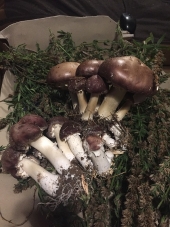

 1
1




Some places need to be wild




Myrth
https://ello.co/myrthcowgirl














Some places need to be wild




Myrth
https://ello.co/myrthcowgirl




Myrth
https://ello.co/myrthcowgirl














Some places need to be wild




 2
2




Sincerely,
Ralph




Ralph Kettell wrote:Hi Eric,
I have a suggestion that might make you a little money and help those of us trying to find good inoculants for our compost. If you cook up a bunch of rice and put it into a large tub and inoculate it with your fungus. The rice will provide a food source for the fungus. You need to clean out everything very well that you are using to grow the fungus. Once you put the rice in the container mix in the fungus mixture. Keep it warm say 30 deg C. It used to work in a tissue culture lab but I still remember the basics.
You should be able to tell when it is ready to sell the evidence of healty growing fungus cultures. The trees were providing it with sugar but now you are providing the sugar in the rice. Once it has grown for a few weeks and it has replicated nicely, you should be able to sell quart bags of the stuff for say $10 plus $10 shipping. It should fit in one of the small postal service fixed price boxes or padded bags. Once the buyer re ceives his supply he can make his own batch of rice and innoculate the batch with your mixture. Later they can dilute and innoculate their compost heap and even apply it directly to their gardens.
You might run it past Dr. Redhawk but I think he would concur.
Myrth
https://ello.co/myrthcowgirl




Growing on my small acre in SW USA; Fruit/Nut trees w/ annuals, Chickens, lamb, pigs; rabbits and in-laws onto property soon.
Long term goal - chairmaker, luthier, and stay-at-home farm dad. Check out my music! https://www.youtube.com/@Dustyandtheroadrunners





Eric Hanson wrote:Hello all,
As is probably no surprise to many on this site, I am highly enthusiastic about almost anything fungal. A couple of weeks ago I stumbled onto a micorrhizal bonanza. I was helping a neighbor take down a hickory tree about 15-20 feet tall and about 4 inches in diameter so he could make room to pull his truck into his driveway. After we cut the tree down, we began to dig out the feeder roots and while I was digging I started to pull up mounds of white fungi intricately wrapped around the fine root hairs coming out of the feeder roots.
The more I dug, the more white, healthy looking mycelia I pulled out of the ground. Eventually I decided it would be criminal to not save this fungi. I found a 1 gallon potting container and filled it up with the wonderful mixture of mycelia, clay soil and root hairs. It was amazing to see so much mycorrhizal fungi so perfectly wrapped around the root hairs. It actually felt a little criminal to disrupt such a beautiful partnership in action.
So the focus of this post is what to do with the fungus now? Most of the gallon is still in contact with both clay and root hairs, so I think that it is ok for the moment. Is there a way to grow this mycelia or use it to deed more? Should I just add it to soil such as around my comfrey plants? Would it help or hurt to add to my wine cap infused wood chip beds? Any other suggestions?
Thanks in advance and I look forward to your ideas.
Eric
List of Bryant RedHawk's Epic Soil Series Threads We love visitors, that's why we live in a secluded cabin deep in the woods. "Buzzard's Roost (Asnikiye Heca) Farm." Promoting permaculture to save our planet.










 1
1




Some places need to be wild
















List of Bryant RedHawk's Epic Soil Series Threads We love visitors, that's why we live in a secluded cabin deep in the woods. "Buzzard's Roost (Asnikiye Heca) Farm." Promoting permaculture to save our planet.

|
Uh oh, we're definitely being carded. Here, show him this tiny ad:
Freaky Cheap Heat - 2 hour movie - HD streaming
https://permies.com/wiki/238453/Freaky-Cheap-Heat-hour-movie
|





